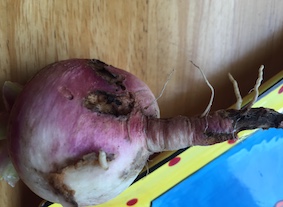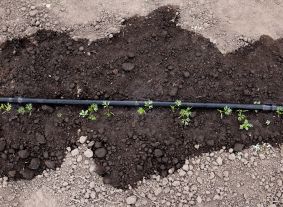Root Maggots and Turnips
Views: 906

Root maggots and turnips—or root maggots and anything you’re about to eat—are not words that should go together. I have had very little experience in growing turnips, with just one previous crop of pure-white turnips that were meant to be harvested quite young, about an inch in diameter. I guess I pulled that crop before any soil-squirming creature could do any damage. But with my most recent turnip crop, however, I’m learning about the pests doing damage right below the soil surface.
Friends with turnip-eating experience had suggested pulling some turnips 10-15 days prior to the suggested 50-60 days to harvest. These early ones, about 1-2 inches in diameter, would be young, tender, and could be used similarly to radishes. I did so, and the young turnips were creamy white and with an unblemished skin. I shaved some into a salad. Tasty! I was looking forward to the harvest when they matured. I had little sign that root maggots were in my future.
Finding the Signs of Root Maggots
I am harvesting my turnips as I see their purple shoulders poke above the soil and I deem them to be sizeable enough for cooking. These aren’t the softball-sized (or larger!) turnips you see in the stores around Thanksgiving. I am aiming for something about the size of a pool ball, at most. This means I’m pulling them just a few at a time while the others size up.
The longer the turnips stay in the ground, the more scarring I am seeing on the turnips’ surface. The scars have the look of tunnels right on the surface. And some of the scarring looks like the cracks on fresh-baked bread that hadn’t been slit sufficiently prior to baking. In addition to damage to the swollen root (the part we eat), many of the rat-tail-like roots appeared to be chewed and damaged. I can attribute all of this damage to root maggots. And just to check, I used a knife to dig into one “tunnel” that seemed filled with debris and found a live root maggot, a white, thin larva about a ¼-inch long, buried within that debris.
What to Do About Root Maggots
Some online searching told me how to handle my root maggot problem. Root maggots’ adult form is a small, inconspicuous fly that looks like a house fly. They only feed on cruciferous crops—items like cabbage, broccoli, turnips, etc. They can overwinter in soil as pupae and emerge again the next season. If root maggots are in your soil, your crop this year has little protection. However, next year try moving the turnip crop to a different location, making it more difficult for the pest to find your turnips. You can also protect your turnip crop by putting a floating row cover over it to prevent the adult females from landing and laying eggs. This only works if you move your turnip crop to a new location; otherwise, the pupae emerge under the row cover—and find themselves among a smorgasbord.
Meet Ellen Wells
When you’re raised on a farm, you can’t help but know a thing or two about gardening. Ellen Wells is our expert on edible gardening.…
Ellen's Recent Posts

Asparagus






